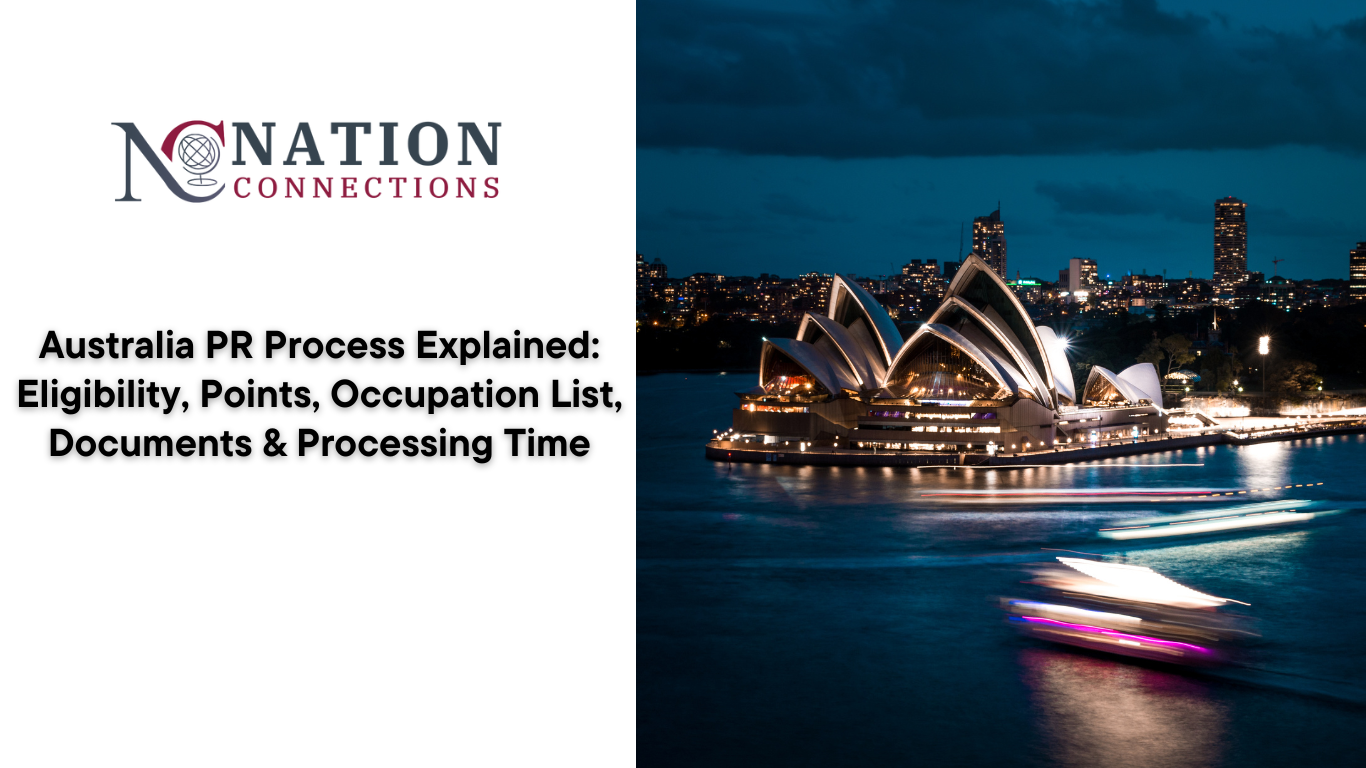Australia is one of the top destinations for skilled professionals seeking permanent residency. The Australia PR Process Explained here will help you understand eligibility, documents, points calculation, and processing time—everything you need to make your Australian dream a reality.
The Australian Permanent Residency (PR) process allows skilled migrants to live, work, and study in Australia indefinitely. It’s part of the country’s effort to attract talent to meet skill shortages and boost economic growth.
There are multiple visa subclasses under which individuals can apply for PR, primarily under the Skilled Migration Program, including Subclass 189, 190, and 491 visas.
Australia uses a points-based immigration system to ensure fairness and transparency. Your eligibility depends on your occupation, qualifications, age, English proficiency, and work experience.
Australia’s PR visa is more than just a ticket to live in a new country—it’s a pathway to stability, opportunity, and growth.
Benefits of Australian PR include:
Freedom to work or study anywhere in Australia
Access to public healthcare (Medicare)
Pathway to Australian citizenship
Right to sponsor eligible family members
Social security benefits after the qualifying period
Besides, Australia offers a multicultural environment, world-class education, and a high standard of living, making it a dream destination for professionals worldwide.
There are three primary pathways to obtain Australian PR:
Skilled Independent Visa (Subclass 189) – For skilled workers without state nomination or sponsorship.
Skilled Nominated Visa (Subclass 190) – For skilled workers nominated by a state or territory government.
Skilled Work Regional (Provisional) Visa (Subclass 491) – For applicants willing to live and work in regional areas of Australia.
Each visa type has unique eligibility and points requirements, but the general process remains similar.
To qualify for the Australia PR Process, you must meet these fundamental eligibility criteria:
Age: Below 45 years at the time of invitation.
English Proficiency: Minimum competent English (IELTS 6 in each band or equivalent).
Skilled Occupation: Your job must be listed on the MLTSSL, STSOL, or ROL.
Work Experience: Relevant and verifiable professional experience.
Health and Character: Must meet Australia’s health and character standards.
The Australia PR points system assesses your eligibility based on several criteria. You need a minimum of 65 points to qualify for an Expression of Interest (EOI).
Points are awarded for factors such as:
Age
Educational qualification
Skilled work experience
English language proficiency
Partner skills
State nomination
Regional study
The more points you accumulate, the higher your chances of receiving an Invitation to Apply (ITA).
Age plays a major role in determining your eligibility for permanent residency.
The age bracket between 25–32 years earns the maximum of 30 points, making it the most favorable group.
Here’s the breakdown:
18–24 years → 25 points
25–32 years → 30 points
33–39 years → 25 points
40–44 years → 15 points
45+ years → Not eligible
If you’re nearing 40, it’s advisable to lodge your Expression of Interest (EOI) early to avoid losing valuable points due to age.
Your educational qualification can add up to 20 points to your score.
The higher the qualification, the better your chances of earning maximum points.
| Qualification | Points |
|---|---|
| Doctorate | 20 points |
| Bachelor’s / Master’s degree | 15 points |
| Diploma or trade qualification | 10 points |
| Recognized qualification or award | 10 points |
If your education was completed in Australia, you may also be eligible for additional Australian study points.
English proficiency is vital for every skilled migration applicant. The Australian Department of Home Affairs accepts IELTS, PTE, TOEFL iBT, and OET test scores.
| English Level | IELTS Equivalent | Points |
|---|---|---|
| Competent | IELTS 6 each band | 0 |
| Proficient | IELTS 7 each band | 10 |
| Superior | IELTS 8 each band | 20 |
To improve your chances of securing an Invitation to Apply (ITA), aim for Superior English proficiency.
Work experience plays a pivotal role in your PR score.
Points are awarded for both overseas and Australian work experience:
| Experience | Points |
|---|---|
| 3–5 years overseas | 5 points |
| 5–8 years overseas | 10 points |
| 8+ years overseas | 15 points |
| 1–3 years in Australia | 5 points |
| 3–5 years in Australia | 10 points |
| 8+ years in Australia | 20 points |
The more years you have in a relevant occupation, the higher your overall PR points.
If your partner is also applying for PR, you can earn extra points for their qualifications, English skills, and occupation.
You can get:
10 points if your partner is skilled and under 45 years
5 points for competent English
10 points if you are single or your partner is already an Australian citizen
This often-overlooked factor can make a crucial difference in competitive invitation rounds.
Choosing to live and work in a regional area of Australia can fetch you 15 additional points under the Subclass 491 visa.
Regional visas are highly beneficial since they:
Provide better chances of receiving a nomination
Lead to permanent residency after three years
Offer incentives for studying or working outside major cities
The occupation list determines whether your job is eligible for migration.
There are three main lists:
Medium and Long-term Strategic Skills List (MLTSSL)
Short-term Skilled Occupation List (STSOL)
Regional Occupation List (ROL)
Some of the most in-demand occupations in 2025 include:
Software Engineer
Registered Nurse
Civil Engineer
Accountant
Electrician
Mechanical Engineer
Secondary School Teacher
Chef
Your occupation must be on one of these lists to qualify for a skilled visa.
To verify if your occupation qualifies for PR:
Visit the Australian Skilled Occupation List page.
Search your occupation and note its ANZSCO code.
Identify the assessing authority for your field.
Prepare documentation accordingly for skills assessment.
This step ensures that your qualifications and experience align with Australia’s job requirements.
The Skill Assessment is a mandatory step before submitting your Expression of Interest (EOI).
Each profession has a designated assessing authority (like Engineers Australia, ACS, VETASSESS, or AHPRA).
The authority verifies:
Your educational qualification
Work experience relevance
English test results
A positive skill assessment is valid for three years, allowing you to lodge your PR application anytime within that period.
The Australia PR Process Explained also includes meticulous documentation.
Here’s the comprehensive checklist:
Valid passport
Recent passport-size photographs
Educational certificates and transcripts
Employment reference letters
English language test results
Skill assessment report
Police clearance certificate
Health examination report
Marriage or birth certificate (if applicable)
Ensure all documents are scanned, certified, and uploaded in English for faster verification.
Once your skill assessment is complete, you must submit an EOI through SkillSelect — an online system managed by the Department of Home Affairs.
In your EOI, you’ll:
Select the visa subclass (189, 190, or 491)
Enter your points score
Provide your occupation and personal details
Your EOI remains valid for two years, during which you may receive an invitation based on your ranking.
If your EOI meets the required score, you’ll receive an Invitation to Apply (ITA) for PR.
Once invited, you have 60 days to submit your complete visa application.
During this phase, ensure all supporting documents are accurate and up-to-date to avoid rejection or delays.
Every applicant must undergo:
Medical examination (by a panel physician)
Police clearance certificates from each country lived in for 12+ months
These ensure that migrants meet Australia’s strict health and character standards, which are non-negotiable in the PR process.
As of 2025, the Australia PR visa cost is approximately:
| Applicant Category | Cost (AUD) |
|---|---|
| Primary applicant | $4,640 |
| Spouse/partner | $2,320 |
| Child (under 18) | $1,160 |
Additional costs may include English tests, skill assessments, medicals, and police checks.
Processing times vary depending on your visa type:
| Visa Subclass | Average Processing Time |
|---|---|
| Subclass 189 | 7–9 months |
| Subclass 190 | 6–8 months |
| Subclass 491 | 8–12 months |
Timely document submission and accurate information can shorten your processing duration.
Missing or incorrect documentation
Unverified employment records
Delayed health or character checks
Changes in immigration policies
Always double-check your application before submission and maintain communication with the authorities if updates are requested.
Achieve Superior English for extra 20 points.
Gain additional skilled experience.
Opt for state or regional nomination.
Keep your EOI updated regularly.
Consult a registered migration agent for complex cases.
These proactive measures can make your application stand out among thousands of applicants.
Increased focus on regional migration programs
Revised occupation lists based on labor market needs
Stricter checks for fraudulent work experience
Faster processing for priority skilled occupations
Always stay updated through the official Department of Home Affairs website before applying.
Once your PR is granted, you can enjoy:
Medicare access
Education subsidies
Pathway to citizenship after 4 years
Work freedom across Australia
Family sponsorship rights
Australia’s PR benefits make it one of the most sought-after immigration destinations globally.
After holding PR status for at least four years (with one year as a permanent resident), you can apply for citizenship.
Citizenship gives you:
The right to vote
Australian passport
Full legal protection abroad
To retain your PR, you must live in Australia for at least two years within a five-year period.
If you plan to travel frequently, apply for a Resident Return Visa (RRV) to keep your PR active.
Providing false or incomplete information
Missing skill assessment documents
Ignoring English test validity
Applying under the wrong occupation code
Submitting after the ITA deadline
Avoiding these errors ensures a smoother and faster approval process.
What is the minimum PR score for Australia?
You need at least 65 points to be eligible for an Expression of Interest.
How long does it take to get PR in Australia?
Typically, between 6 to 12 months, depending on your visa subclass.
Can I apply for PR without a job offer?
Yes, if your occupation is on the eligible list and you meet the points requirement.
What is the maximum age limit for PR?
You must be under 45 years old when invited to apply.
Can I include my family in the PR application?
Yes, you can include your spouse and dependent children.
Is IELTS mandatory for PR?
Yes, English proficiency proof is mandatory for all PR applicants.
The Australia PR Process Explained provides a transparent, merit-based system for skilled professionals worldwide.
By understanding the eligibility, points, occupation list, documents, and processing time, you can strategically plan your migration journey.
With careful preparation, attention to detail, and the right strategy, your dream of becoming a permanent resident in Australia is closer than you think. 🌏🇦🇺




